I have a lot of business cards. Every significant change in my career was accompanied with a new set of business cards. Business cards came in sets of 500 or 1000. I used at most 50 out of any set, which means I have lots left over. I’ve used them to play games when the kids were young, to scribble notes on, and as cue cards when public speaking.
Business cards are fascinating historical artifacts. Each a snapshot of a moment in time. The graphical design that takes you straight back to that decade. The job title you only vaguely remember having. The way that each business card comes from the beginning of my career with each company. After all, I have hundreds of the things, why bother replacing them just because my job title changed.
So, here’s my career viewed through the medium of business cards.
Cambridge University (1985-1991)
We start with an anticlimax. I spend three years as an undergraduate at Cambridge University, followed by another three as a graduate student in the Computer Graphics research group. I wasn’t one of those sad people in the Enterprise Society that had business cards.
One day, while writing up my thesis, I saw a job advert on the departmental noticeboard. They were looking for a post-doctoral researcher with computer graphics experience.
The Martin Centre (1991-1997)


The Martin Centre was my first proper job (well as close as you can get to a proper job in academia) and my first business card. I like the generally understated design (apart from the ridiculous number of different fonts). The Martin Centre is the post graduate research wing of the Architecture department (buildings rather than software). The logo is based on early work on geometric form. The outline square on the left represents a courtyard, the square on the right a tower block. Perhaps surprisingly, both have the same floor area.
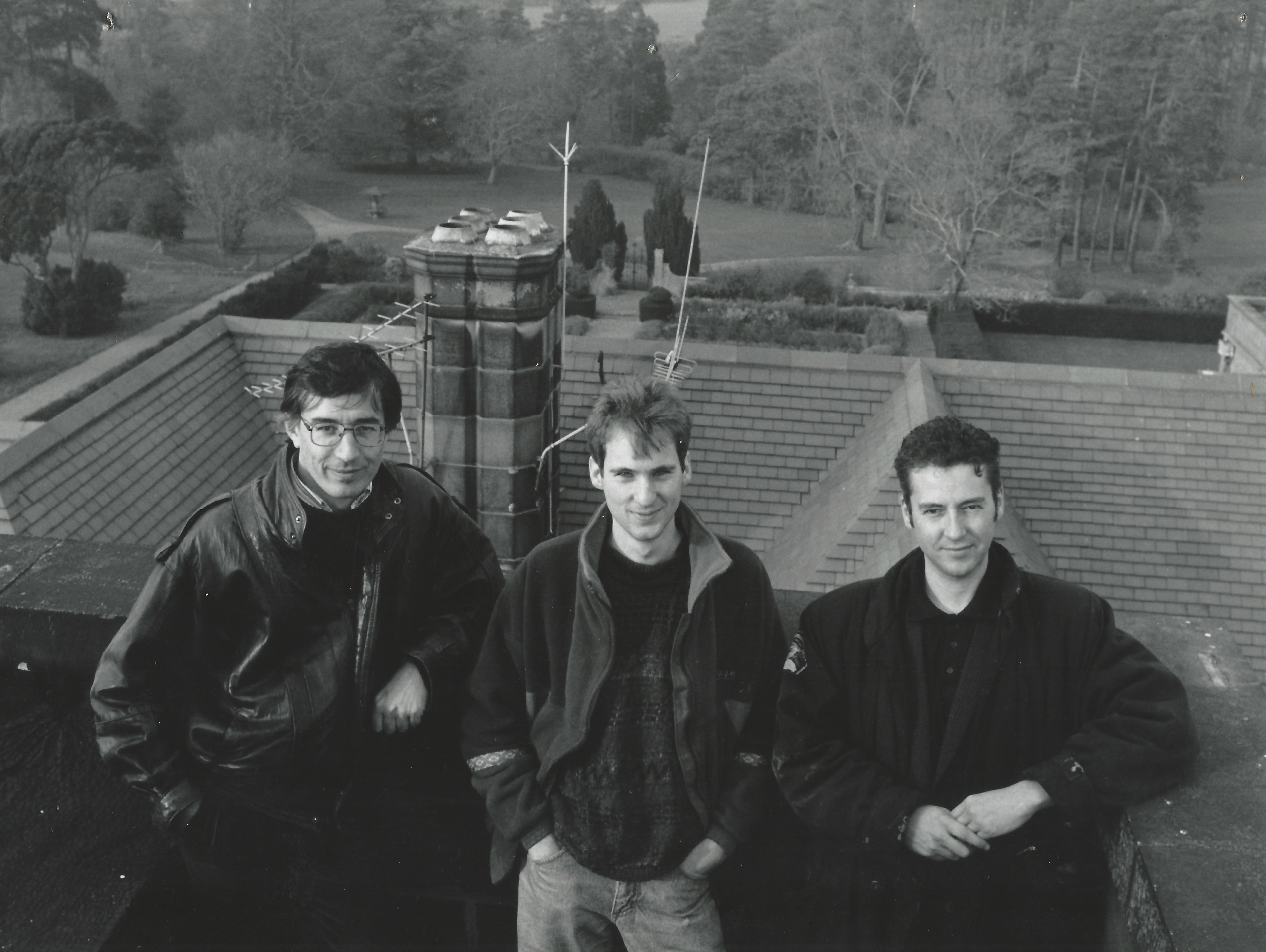

Simon Schofield and I were hired by Paul Richens, the director of the centre. Paul had secured a grant for a computer laboratory with the open ended remit to do something interesting in the field of computers and architecture. I worked on a variety of 3D graphics projects including one of the first interactive solid modellers. Simon had an art and multimedia background and worked on a 3D painting tool that was commercialized as Piranesi.
The idea for what became Navisworks was sparked by a visit from a pair of architects that were working on a refurb of Heathrow Airport Terminal 4. They’d made a 3D model for photorealistic rendering and were wondering if it could be used for interactive walkthroughs. At one million triangles, it was clearly way too big for the graphics hardware available at the time. They were disappointed but did leave us the model. Which got me to thinking - how could you interact with a model that was too large to render in real time?


The large model viewing prototype that I built worked well enough that we included a live demo in an exhibition of work being done in the architecture department. The exhibition was opened by the university chancellor, the Duke of Edinburgh. Check out the Silicon Graphics workstation, CRT monitor caught in mid refresh and the SpaceBall controller in my left hand.
We had lots of visitors from industry, one of whom was a director of LightWork Design, a graphics software company based in Sheffield. He was looking for potential new products and liked the look of the large model viewing demo. By this time I’d been at the Martin Centre for five years and was getting tired of academia. When LightWork Design licensed the large model viewing technology, I went with it.
LightWork Design (1997-2002)
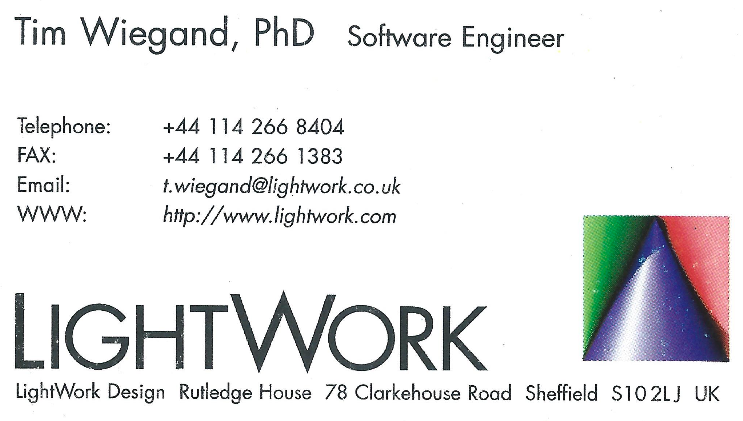

LightWork Design had two existing products. LightWorks was a photorealistic rendering toolkit and MachineWorks was a CNC machining simulation toolkit. Their business model was to license their toolkits to other software companies that create end user software. It was clear that I would be working on a software toolkit for large model viewing called SomethingWorks.
Business cards now came in color! It’s pretty restrained, certainly in comparison with websites at the time. I don’t know who was responsible for adding “PhD”. I’ve never used my doctoral title professionally (outside of academia).
I spent a couple of years working on a large model viewing toolkit. LightWork Design found it hard to get their existing CAD system customer base interested. I created a large model viewing application to use as a testbed and demo for the toolkit. We still didn’t have any takers for the toolkit but found lots of people interested in using the viewer with their own models. And so NavisWorks was born.
Fast forward a couple more years and we had a small development team, a product manager, a sales person, and a general manager. At this point the founders of LightWork Design were thinking about retirement and an exit strategy. They decided to spin each of their product lines out as a separate company. LightWorks (now acquired by Siemens), MachineWorks and NavisWorks.
NavisWorks Ltd (2002-2007)
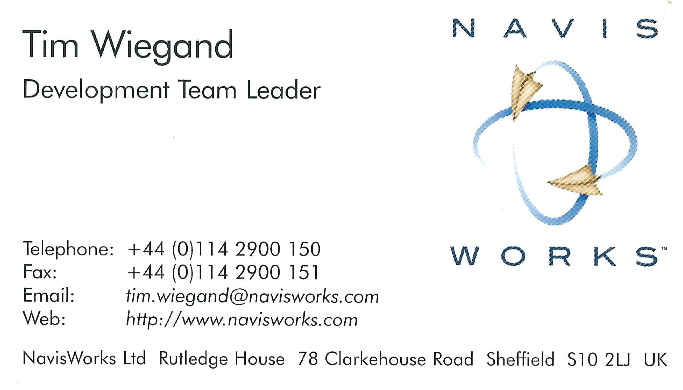

My favorite business card. I do miss the old NavisWorks logo. This is from before my title changed to the more grandiose “Chief Technology Officer”. You won’t get taken seriously as a startup if you don’t all give yourselves C-level titles.
NavisWorks grew steadily and eventually came to the notice of Autodesk. The LightWork Design founders’ plan came to fruition and NavisWorks became the first of their companys to be sold.
Autodesk (2007-2022)
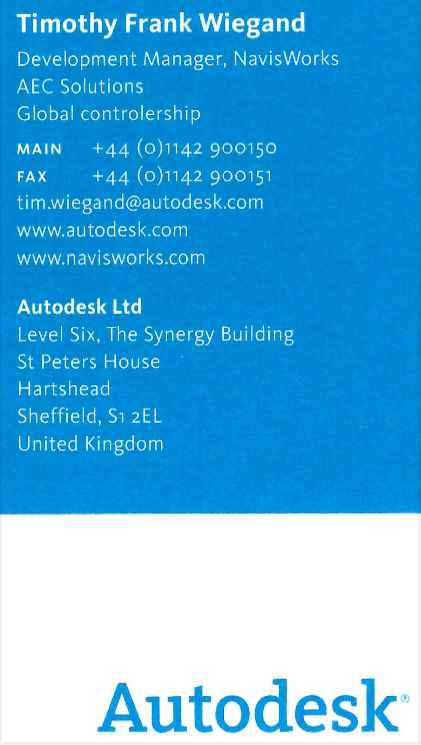

That is one ugly business card. Lots of things were set up for us after acquisition, business cards included. Whatever junk had been entered in the HR system was splurged across the card. Good job I only have one second name. I have no idea what “Global controlership” refers to.
As part of the acquisition process everyone was mapped to the equivalent Autodesk role. At Navisworks I had been a combination of engineering manager, software architect, program manager and systems admin. At Autodesk the closest box was engineering manager. I soon realized that I wasn’t cut out to be a dedicated people manager and switched lanes to Software Architect.
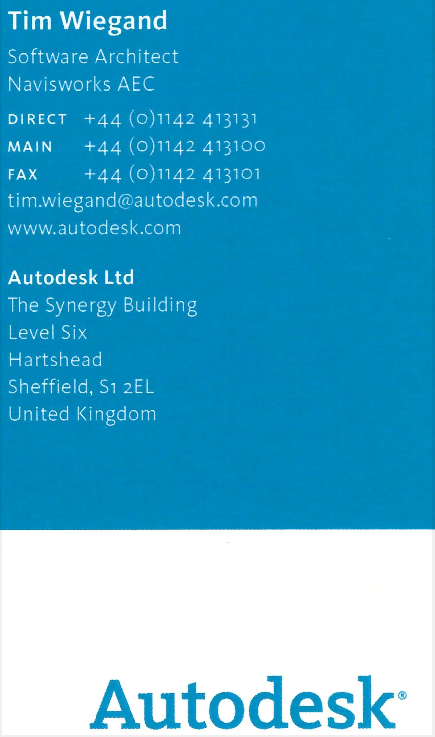

I ordered these myself. I couldn’t change the design but I could at least fix the content. I did say that I never replaced business cards just because I had a new job title. In this case, it wasn’t my doing.
If you look closely you’ll see that Navisworks now has a small “w”. This change was a big deal at the time. SolidWorks was a major competitor for Autodesk and the VPs felt strongly that we needed to change our name to distance ourselves. You wouldn’t believe how painful it was to hunt down and change every large “W”. Ironically, a couple of years later, Autodesk launched their new infrastructure conceptual design tool and decided to call it InfraWorks.
The Candid Startup (2022-)
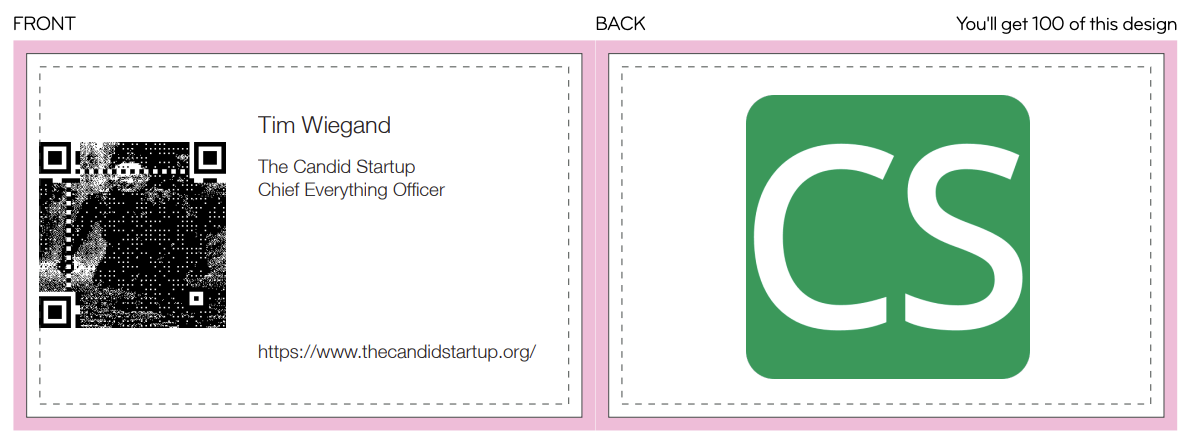

So far, I’ve had no reason to make myself a Candid Startup business card. Just for fun I used the first “make your own business card” site that Google found for me, to mock one up. I used my profile picture to create a QR code for the blog and used the blog’s favicon for the other side.
What do you think? I’m glad to see that you no longer need to order 1000 at a time. Is it worth £28 plus p&p to run off 100?